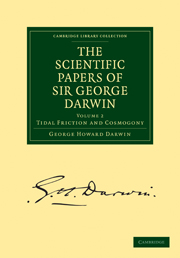Book contents
- Frontmatter
- PREFACE
- Contents
- Chronological List of Papers with References to the Volumes in which they are or probably will be contained
- Erratum in Vol. I
- TIDAL FRICTION AND COSMOGONY
- 1 On the Bodily Tides of Viscous and Semi-elastic Spheroids, and on the Ocean Tides upon a Yielding Nucleus
- 2 Note on Thomson's Theory of the Tides of an Elastic Sphere
- 3 On the Precession of a Viscous Spheroid, and on the Remote History of the Earth
- 4 Problems connected with the Tides of a Viscous Spheroid
- 5 The Determination of the Secular Effects of Tidal Friction by a Graphical Method
- 6 On the Secular Changes in the Elements of the Orbit of a Satellite revolving about a Tidally Distorted Planet
- 7 On the Analytical Expressions which give the History of a Fluid Planet of Small Viscosity, attended by a Single Satellite
- 8 On the Tidal Friction of a Planet attended by Several Satellites, and on the Evolution of the Solar System
- 9 On the Stresses caused in the Interior of the Earth by the Weight of Continents and Mountains
- INDEX
4 - Problems connected with the Tides of a Viscous Spheroid
Published online by Cambridge University Press: 07 September 2010
- Frontmatter
- PREFACE
- Contents
- Chronological List of Papers with References to the Volumes in which they are or probably will be contained
- Erratum in Vol. I
- TIDAL FRICTION AND COSMOGONY
- 1 On the Bodily Tides of Viscous and Semi-elastic Spheroids, and on the Ocean Tides upon a Yielding Nucleus
- 2 Note on Thomson's Theory of the Tides of an Elastic Sphere
- 3 On the Precession of a Viscous Spheroid, and on the Remote History of the Earth
- 4 Problems connected with the Tides of a Viscous Spheroid
- 5 The Determination of the Secular Effects of Tidal Friction by a Graphical Method
- 6 On the Secular Changes in the Elements of the Orbit of a Satellite revolving about a Tidally Distorted Planet
- 7 On the Analytical Expressions which give the History of a Fluid Planet of Small Viscosity, attended by a Single Satellite
- 8 On the Tidal Friction of a Planet attended by Several Satellites, and on the Evolution of the Solar System
- 9 On the Stresses caused in the Interior of the Earth by the Weight of Continents and Mountains
- INDEX
Summary
In the following paper several problems are considered, which were alluded to in my two previous papers on this subject.
The paper is divided into sections which deal with the problems referred to in the table of contents. It was found advantageous to throw the several investigations together, because their separation would have entailed a good deal of repetition, and one system of notation now serves throughout.
It has, of course, been impossible to render the mathematical parts entirely independent of the previous papers, to which I shall accordingly have occasion to make a good many references.
As the whole inquiry is directed by considerations of applicability to the earth, I shall retain the convenient phraseology afforded by speaking of the tidally distorted spheroid as the earth, and of the disturbing body as the moon.
It is probable that but few readers will care to go through the somewhat complex arguments and analysis by which the conclusions are supported, and therefore in the fourth part a summary of results is given, together with some discussion of their physical applicability to the case of the earth.
Secular distortion of the spheroid, and certain tides of the second order
In considering the tides of a viscous spheroid, it was supposed that the tidal protuberances might be considered as the excess and deficiency of matter above and below the mean sphere—or more strictly the mean spheroid of revolution which represents the average shape of the earth.
- Type
- Chapter
- Information
- The Scientific Papers of Sir George DarwinTidal Friction and Cosmogony, pp. 140 - 194Publisher: Cambridge University PressPrint publication year: 2009First published in: 1908



